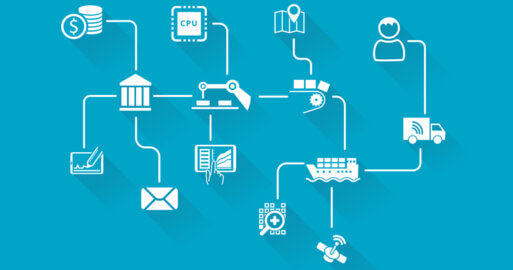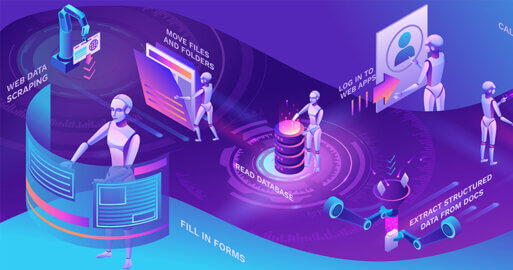Hyperautomation: Just a Hype or The Upcoming Breakthrough?

Manual tasks or poorly automated processes are clearly disadvantageous, introducing inefficiencies, errors and delays that hinder overall performance. As organizations strive to remain competitive and adaptable, it’s becoming increasingly evident that the future of business lies in comprehensive automation – or in other words: hyperautomation. As we venture into this automated future, companies can harness the power of technology to propel themselves toward enhanced output, improved customer experiences and sustainable growth.
In this blog, we’ll examine what hyperautomation is and how it’s different from the kind of automation we’re already familiar with. We’ll also discover how to put hyperautomation into practice and how SEEBURGER can help you achieve new dimensions of automation.
What is hyperautomation and how does it work?
Hyperautomation is a holistic approach of automation addressing the entire lifecycle of automation. It has emerged as a transformative solution referring to the comprehensive use of advanced technologies to automate and augment business processes, going beyond traditional process automation.
In essence, hyperautomation combines a variety of automation technologies in order to optimize and harmonize complex processes. It does not only integrate robotic process automation (RPA), digital process automation (DPA) and business process automation (BPA) but also artificial intelligence (AI), machine learning (ML) and other advanced technologies. The difference between traditional process automation and hyperautomation lies in the scope and focus of each. While process automation is a more general term that refers to the use of technology to perform tasks or processes without human intervention, hyperautomation specifically emphasizes the integration and orchestration of multiple automation tools and technologies to create a comprehensive and sophisticated automation solution. Hyperautomation seeks to achieve a higher level of automation maturity by combining different technologies to address complex and dynamic end-to-end business processes instead of single tasks.
To establish a thorough automation strategy that spans the entire business and includes the automation of numerous operations, it is crucial to integrate, link, and coordinate these automated processes through an integration platform. This ensures a cohesive and holistic approach to automation and suggests that hyperautomation is not a process but rather a summary or combination of single automation initiatives that form an integral overall automation effort across the entire business.

Benefits of hyperautomation
The benefits of automation are clearly obvious and include overall efficiency and faster decision-making processes through cost cutting and fewer time-intensive processes based on manual entry, which is prone to error.
Hyperautomation addresses all these benefits and goes beyond them by facilitating a faster route to involve all stakeholders in the process of reshaping business operations. This is made possible by automating intricate tasks that depend on human expertise. Ultimately, the goal of hyperautomation is to establish a more adaptable and swiftly responsive organization that can quickly adjust to dynamically shifting market conditions.
Enhancing process automation (BPA, RPA and DPA) with ML and AI and other tools results in the formation of an intelligent digital workforce assuming the responsibility of executing repetitive tasks, thereby enhancing overall employee productivity. These digital agents play a pivotal role in driving the hyperautomation revolution. They possess the capability to seamlessly integrate with diverse business applications, process both structured and unstructured data, perform data analysis, make informed decisions, identify existing processes and unearth novel prospects for automation.

By automating tasks and data that were previously beyond reach, hyperautomation offers an additional substantial advantage: the creation of a digital twin for the organization. This digital twin unveils previously hidden correlations among processes, functions and crucial performance indicators, providing newfound visibility into their interactions.
Hyperautomation 101
Having explored what hyperautomation is and what benefits it brings to the table, let’s look at what hyperautomation actually looks like in practice.
Hyperautomation is an ongoing journey that requires collaboration, continuous learning and adaptability. It’s essential to have a dedicated team with expertise in automation, process analysis and technology to guide the implementation process effectively.
- Start with a thorough analysis of your organization’s pain points, inefficiencies and areas that could benefit from automation. Use process mining tools to gain insights into your existing workflows and identify bottlenecks and opportunities for automation. Also, prioritize processes based on their complexity, potential impact and feasibility for automation.
- Define clear goals and objectives for the hyperautomation efforts, such as improving efficiency, reducing costs and enhancing customer experiences. Develop a roadmap that outlines the processes to be automated, the technologies to be employed and the expected outcomes, and find a technology provider, such as SEEBURGER, that matches these needs.
- Design automated workflows that encompass the selected technologies and align with your defined goals and develop automation components needed for the whole hyperautomation initiative. Integrate these automation components with existing systems, databases and applications to ensure smooth data exchange and communication.
- Test automated processes in a controlled environment, as part of a comprehensive change management plan, to identify and rectify any errors or issues, as well as to communicate the changes and benefits of hyperautomation to employees and other stakeholders. This may encompass training and support to help users adapt to the new automated processes.
- Roll out the automated processes in stages or phases to minimize disruptions and ensure a smooth transition. Then, don’t close the project after a successful rollout — be sure to continuously monitor the performance of automated processes using analytics and dashboards to identify areas for improvement, and optimize the automated workflows over time.
- Expand the scope of hyperautomation to cover additional processes and functions, after the initial processes are successfully automated. Look for opportunities to leverage the digital twin concept to gain deeper insights and optimize organizational performance. Also, stay current with emerging automation technologies and trends to maintain a competitive edge.
How SEEBURGER can help with hyperautomation
As step 2 above mentions, finding a suitable software and services provider is a pivotal step toward realizing your hyperautomation efforts. The low-code and cloud-based SEEBURGER BIS Platform offers dynamic, end-to-end automation capabilities with a rules-based process engine to help you hyperautomate and digitalize your end-to-end business processes. Configure and track any automation scenario that your business needs and when you need it, and configure automated digital processes and workflows.
There are many areas that we can seamlessly connect for you to support your overall hyperautomation strategy and initiatives as illustrated by these simple use cases for automation with BIS:
- Ensure data integrity and optimize resource usage through smart retry to automatically resume interrupted processes until normal functionality is restored.
- Automate message tracking with a dynamic feature enabling efficient data analysis and processing by utilizing information from the Message Tracking system that allows for tailored queries, automated actions based on criteria, and easy export with analytical tools.
- Handle large volumes of data transfers efficiently, reliable and securely between systems.
- Ensure API security, reliability and accuracy through API testing.
- Automate assembly line production and supply chain processes to facilitate real-time tracking and reduce stock-outs and excess inventory.
Case Study
Learn how PUMA automated their B2B communications with SAP S/4HANA and SEEBURGER Cloud Integration Services.
Read nowThank you for your message
We appreciate your interest in SEEBURGER
Get in contact with us:
Please enter details about your project in the message section so we can direct your inquiry to the right consultant.
Written by: Sandrine Wagner
Sandrine joined our marketing team in August 2021 as an editor and campaign manager. She holds a Bachelor's degree in International Business and brings fundamental expertise in FSI and FinTech to our marketing team through her network engagements, previous internships and student jobs. After her internship at SEEBURGER, she joined our editorial team full-time and has since been involved in writing creative and technical content for our blog and other resources in German and English. Her campaign management work focuses on trends and innovations in various sectors, most notably the financial industry. In her free time, Sandrine enjoys exploring nature with her pets, learning foreign languages and reading literature.





